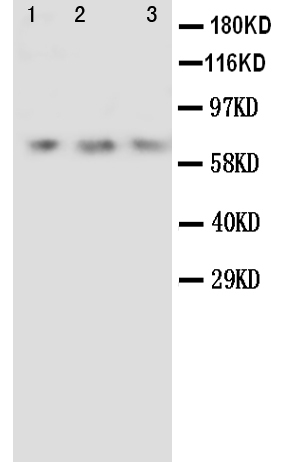Anti-Angiopoietin-2 Antibody
- SPECIFICATION
- CITATIONS
- PROTOCOLS
- BACKGROUND

Application
| WB |
|---|---|
| Primary Accession | O15123 |
| Host | Rabbit |
| Reactivity | Human |
| Clonality | Polyclonal |
| Format | Lyophilized |
| Description | Rabbit IgG polyclonal antibody for Angiopoietin-2(ANGPT2) detection. Tested with WB in Human. |
| Reconstitution | Add 0.2ml of distilled water will yield a concentration of 500ug/ml. |
| Gene ID | 285 |
|---|---|
| Other Names | Angiopoietin-2, ANG-2, ANGPT2 |
| Calculated MW | 56919 MW KDa |
| Application Details | Western blot, 0.1-0.5 µg/ml, Human |
| Subcellular Localization | Secreted. |
| Protein Name | Angiopoietin-2(ANG-2) |
| Contents | Each vial contains 5mg BSA, 0.9mg NaCl, 0.2mg Na2HPO4, 0.05mg Thimerosal, 0.05mg NaN3. |
| Immunogen | A synthetic peptide corresponding to a sequence at the C-terminus of human Angiopoietin 2(454-468aa NLNGMYYPQRQNTNK). |
| Purification | Immunogen affinity purified. |
| Cross Reactivity | No cross reactivity with other proteins |
| Storage | At -20˚C for one year. After r˚Constitution, at 4˚C for one month. It˚Can also be aliquotted and stored frozen at -20˚C for a longer time.Avoid repeated freezing and thawing. |
| Sequence Similarities | Contains 1 fibrinogen C-terminal domain. |
| Name | ANGPT2 |
|---|---|
| Function | Binds to TEK/TIE2, competing for the ANGPT1 binding site, and modulating ANGPT1 signaling (PubMed:15284220, PubMed:19116766, PubMed:19223473, PubMed:9204896). Can induce tyrosine phosphorylation of TEK/TIE2 in the absence of ANGPT1 (PubMed:15284220, PubMed:19116766, PubMed:19223473, PubMed:9204896). In the absence of angiogenic inducers, such as VEGF, ANGPT2-mediated loosening of cell-matrix contacts may induce endothelial cell apoptosis with consequent vascular regression. In concert with VEGF, it may facilitate endothelial cell migration and proliferation, thus serving as a permissive angiogenic signal (PubMed:15284220, PubMed:19116766, PubMed:19223473, PubMed:9204896). Involved in the regulation of lymphangiogenesis (PubMed:32908006). |
| Cellular Location | Secreted. |

Thousands of laboratories across the world have published research that depended on the performance of antibodies from Abcepta to advance their research. Check out links to articles that cite our products in major peer-reviewed journals, organized by research category.
info@abcepta.com, and receive a free "I Love Antibodies" mug.
Provided below are standard protocols that you may find useful for product applications.
Background
Angiopoietin 1 and Angiopoietin 2 are important for development of the endothelium, by regulating tyrosine phosphorylation of the membrane receptor Tie 2. Angiopoietin 2 is only 60% homologous with Angiopoietin 1. Angiopoietin-2 is a naturally occurring antagonist of angiopoietin-1 that competes for binding to the TIE2 receptor and blocks ANGPT1-induced TIE2 autophosphorylation. Angiopoietin 1 binding to Tie 2 causes phosphorylation of the receptor. Angiopoietin 2 competes for this binding, and thus blocks receptor phosphorylation. Angiopoietin 2 expression occurs at sites of vascular remodelling: dorsal aorta and major aortic branches, ovary, placenta and uterus.
If you have used an Abcepta product and would like to share how it has performed, please click on the "Submit Review" button and provide the requested information. Our staff will examine and post your review and contact you if needed.
If you have any additional inquiries please email technical services at tech@abcepta.com.













 Foundational characteristics of cancer include proliferation, angiogenesis, migration, evasion of apoptosis, and cellular immortality. Find key markers for these cellular processes and antibodies to detect them.
Foundational characteristics of cancer include proliferation, angiogenesis, migration, evasion of apoptosis, and cellular immortality. Find key markers for these cellular processes and antibodies to detect them. The SUMOplot™ Analysis Program predicts and scores sumoylation sites in your protein. SUMOylation is a post-translational modification involved in various cellular processes, such as nuclear-cytosolic transport, transcriptional regulation, apoptosis, protein stability, response to stress, and progression through the cell cycle.
The SUMOplot™ Analysis Program predicts and scores sumoylation sites in your protein. SUMOylation is a post-translational modification involved in various cellular processes, such as nuclear-cytosolic transport, transcriptional regulation, apoptosis, protein stability, response to stress, and progression through the cell cycle. The Autophagy Receptor Motif Plotter predicts and scores autophagy receptor binding sites in your protein. Identifying proteins connected to this pathway is critical to understanding the role of autophagy in physiological as well as pathological processes such as development, differentiation, neurodegenerative diseases, stress, infection, and cancer.
The Autophagy Receptor Motif Plotter predicts and scores autophagy receptor binding sites in your protein. Identifying proteins connected to this pathway is critical to understanding the role of autophagy in physiological as well as pathological processes such as development, differentiation, neurodegenerative diseases, stress, infection, and cancer.


